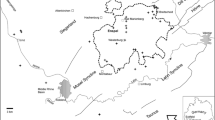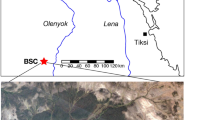Abstract
Results of a detailed bathymetric survey of Crater Lake conducted in 2000, combined with previous results of submersible and dredge sampling, form the basis for a geologic map of the lake floor and a model for the filling of Crater Lake with water. The most prominent landforms beneath the surface of Crater Lake are andesite volcanoes that were active as the lake was filling with water, following caldera collapse during the climactic eruption of Mount Mazama 7700 cal. yr B.P. The Wizard Island volcano is the largest and probably was active longest, ceasing eruptions when the lake was 80 m lower than present. East of Wizard Island is the central platform volcano and related lava flow fields on the caldera floor. Merriam Cone is a symmetrical andesitic volcano that apparently was constructed subaqueously during the same period as the Wizard Island and central platform volcanoes. The youngest postcaldera volcanic feature is a small rhyodacite dome on the east flank of the Wizard Island edifice that dates from 4800 cal. yr B.P. The bathymetry also yields information on bedrock outcrops and talus/debris slopes of the caldera walls. Gravity flows transport sediment from wall sources to the deep basins of the lake. Several debris-avalanche deposits, containing blocks up to 280 m long, are present on the caldera floor and occur below major embayments in the caldera walls. Geothermal phenomena on the lake floor are bacterial mats, pools of solute-rich warm water, and fossil subaqueous hot spring deposits. Lake level is maintained by a balance between precipitation and inflow versus evaporation and leakage. High-resolution bathymetry reveals a series of up to nine drowned beaches in the upper 30 m of the lake that we propose reflect stillstands subsequent to filling of Crater Lake. A prominent wave-cut platform between 4 m depth and present lake level that commonly is up to 40 m wide suggests that the surface of Crater Lake has been at this elevation for a very long time. Lake level apparently is limited by leakage through a permeable layer in the northeast caldera wall. The deepest drowned beach approximately corresponds to the base of the permeable layer. Among a group of lake filling models, our preferred one is constrained by the drowned beaches, the permeable layer in the caldera wall, and paleoclimatic data. We used a precipitation rate 70% of modern as a limiting case. Satisfactory models require leakage to be proportional to elevation and the best fit model has a linear combination of 45% leakage proportional to elevation and 55% of leakage proportional to elevation above the base of the permeable layer. At modern precipitation rates, the lake would have taken 420 yr to fill, or a maximum of 740 yr if precipitation was 70% of the modern value. The filling model provides a chronology for prehistoric passage zones on postcaldera volcanoes that ceased erupting before the lake was filled.
Similar content being viewed by others
References
Atwood, W. W. Jr., 1935. The glacial history of an extinct volcano, Crater Lake National Park. Journal of Geology 43: 142–168.
Bacon, C. R. & Manuel Nathenson, 1996. Geothermal resources in the Crater Lake area, Oregon. U. S. Geological Survey Open-File Report 96–663, 34 pp.
Bacon, C. R., J. V. Gardner, L. A. Mayer, M. W. Buktenica, P. Dartnell, D. W. Ramsey & J. E. Robinson, 2002. Morphology, volcanism, and mass wasting in Crater Lake, Oregon. Geological Society of America Bulletin 114: 675–692.
Barnosky, C. W., P. M. Anderson & P. J. Bartlein, 1987. The northwestern U.S. during deglaciation; Vegetational history and paleoclimatic implications. In Ruddiman, W. F. & H. E. Wright Jr. (eds), North America and Adjacent Oceans During the Last Deglaciation. The Geology of North America, Geological Society of America K-3: 289–321.
Byrne, J. V., 1965. Morphometry of Crater Lake, Oregon. Limnology and Oceanography 10: 462–465.
Collier, R. W., J. Dymond & J. McManus, 1991. Studies of hydrothermal processes in Crater Lake, OR. Oregon State University College of Oceanography Report 90–7, 317 pp.
Dymond, J. & R. W. Collier, 1989. Bacterial mats from Crater Lake, Oregon and their relationship to possible deep-lake hydrothermal venting. Nature 342: 673–675.
Fuller, R. E., 1931. The aqueous chilling of basaltic lava on the Columbia River Plateau. American Journal of Science 5th series. 21(124): 281–300.
Gardner, J. V. & P. Dartnell, 2001. 2000 multibeam sonar survey of Crater Lake, Oregon: Data, GIS, images, and movies. U. S. Geological Survey Digital Data Series DDS-72, 1 CD-ROM.
Gardner, J. V., P. Dartnell, L. Hellequin, C. R. Bacon, L. A. Mayer, M. W. Buktenica & J. C. Stone, 2001. Bathymetry and selected perspective views of Crater Lake, OR. U. S. Geological Survey Water Resources Investigation Report 01-4046, 2 plates, scale 1:15,000, http://walrus.wr.usgs.gov/pacmaps.
Hoffman, F. O., 1999. The filling of Crater Lake. Nature Notes from Crater Lake 30: 10–13.
Jones, J. G. & P. H. H. Nelson, 1970. The flow of basalt lava from air into water — its structural expression and stratigraphic significance. Geological Magazine 107: 13–19.
Moore, J. G., D. A. Clague, R. T. Holcomb, P. W. Lipman, W. R. Normark & M. E. Torresan, 1989. Prodigious submarine landslides on the Hawaiian Ridge. Journal of Geophysical Research 94: 17,465–17,484.
Nathenson, M., 1992. Water balance for Crater Lake, Oregon. U. S. Geological Survey Open-File Report 92–505, 33 pp.
Nelson, C. H., A. W. Meyer, D. Thor & M. Larsen, 1986. Crater Lake, Oregon: A restricted basin with base-of-slope aprons of nonchannelized turbidites. Geology 14: 238–241.
Nelson, C. H., P. R. Carlson & C. R. Bacon, 1988. The Mount Mazama climactic eruption (6900 BP) and resulting convulsive sedimentation on the continent, ocean basin, and Crater Lake caldera floor. In Clifton, H. E. (ed), Sedimentologic Consequences of Convulsive Geologic Events, Geological Society of America Special Paper 229: 37–57.
Nelson, C. H., C. R. Bacon, S. W. Robinson, D. P. Adam, J. P. Bradbury, J. H. Barber Jr., D. Schwartz & G. Vagenas, 1994. The volcanic, sedimentologic, and paleolimnologic history of the Crater Lake caldera floor, Oregon: Evidence for small caldera evolution. Geological Society of America Bulletin 106: 684–704.
Phillips, K. N., 1968. Hydrology of Crater, East, and Davis Lakes, Oregon. with a section on Chemistry of the lakes, by A. S. Van Denburgh. U. S. Geological Survey Water-Supply Paper 1859-E, 60 pp.
Ramsey, D. W., P. Dartnell, C. R. Bacon, J. E. Robinson & J. V. Gardner, 2003. Crater Lake revealed. U. S. Geological Survey Geological Investigation Series Map I-2790, 1 plate.
Redmond, K. T., 1990. Crater Lake climate and lake level variability. In Drake E. T., G. L. Larson, J. Dymond & R. Collier (eds), Crater Lake, an ecosystem study: Pacific Div. American Association for the Advancement of Science, San Francisco, 127–141.
Stine, S., 1990. Late Holocene fluctuations of Mono Lake, eastern California. Paleogeography, Paleoclimatology, and Paleoecology 78: 333–381.
Stine, S., 1994. Extreme and persistent drought in California and Patagonia during medieval time. Nature 369: 546–549.
Wheat, C. G., J. McManus, J. Dymond, R. Collier & M. Whiticar, 1998. Hydrothermal fluid circulation through the sediment of Crater Lake, Oregon: Pore water and heat flow constraints. Journal of Geophysical Research 103: 9931–9944.
Williams, D. L. & R. P. Von Herzen, 1983. On the terrestrial heat flow and physical limnology of Crater Lake, Oregon. Journal of Geophysical Research 88: 1094–1104.
Williams, H., 1961. The floor of Crater Lake, Oregon. American Journal of Science 259: 81–83.
Author information
Authors and Affiliations
Corresponding author
Rights and permissions
About this article
Cite this article
Nathenson, M., Bacon, C.R. & Ramsey, D.W. Subaqueous geology and a filling model for Crater Lake, Oregon. Hydrobiologia 574, 13–27 (2007). https://doi.org/10.1007/s10750-006-0343-5
Issue Date:
DOI: https://doi.org/10.1007/s10750-006-0343-5




